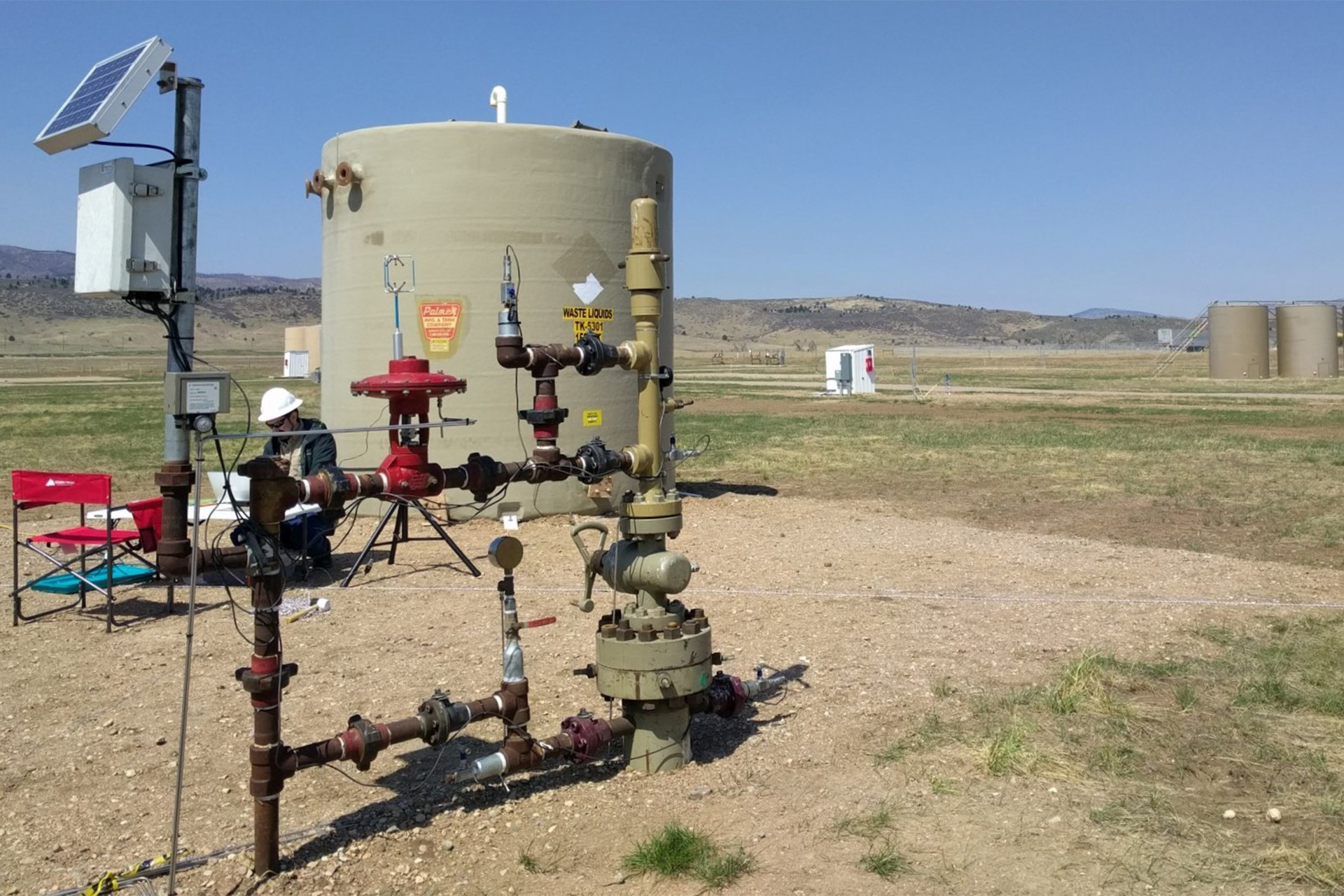Video by Ty Betts
Have you ever caught a whiff of something like rotten eggs and realized there might be a gas leak nearby? That smell is a component added to natural gas, something that is normally colorless and odorless, to help people recognize leaks. However, it’s a bit more complicated than that to effectively detect harmful leaks of natural gas.
There are many factors in how natural gas leaks and where it goes from there. Now, in the first phase of a two-year project, a team of researchers at Colorado State University, in collaboration with the University of Texas at Arlington, are performing experiments to understand the degree to which environmental conditions affect natural gas migration below the surface, as well as what happens once it leaks into the air.
The project is sponsored in part by the U.S. Department of Energy’s Advanced Research Projects Agency–Energy (ARPA-E), the Pipeline and Hazardous Materials Safety Administration (PHMSA) and five major industry distributors: PG&E, Con Edison, Southern California Gas, Xcel Energy and Dominion Energy.
Environmental health and safety
This kind of research is important because natural gas leaks can be dangerous. Daniel Zimmerle, director of the Methane Emissions Testing and Evaluation Center (METEC) and senior research associate at the CSU Energy Institute, said these issues should matter to everyone.
“Gas pipes are running underneath your street, and if natural gas accumulates in a confined space, that can be dangerous,” he said. “What’s more, methane is 25 times more powerful than CO2 in terms of driving climate change. So you want to keep it in pipes.”
In a more practical sense, leaks are a hazard to landscaping. “When you need to repair a leak, you want to minimize how much they dig up your street or front yard,” Zimmerle added. “Knowing more about where the leak is, how urgently it needs to be repaired and how it should be monitored has a direct impact on the consumer.”

“Knowing more about where the leak is, how urgently it needs to be repaired and how it should be monitored has a direct impact on the consumer.”
— Daniel Zimmerle, director of METEC and senior research associate at CSU Energy Institute
Engineering and public health are combined in this issue. Kathleen Smits, associate professor in the Department of Civil Engineering at the University of Texas at Arlington and principal investigator on the study, said she is motivated by engineering research that connects to environmental health and safety.
“I have been studying gas migration through soils for many years as applied to landmine detection and environmental remediation, like contaminant vapors migrating into residential structures,” Smits said. “In terms of natural gas, which is predominantly composed of methane, we really don’t understand how the environmental conditions both above and below ground affect the methane behavior.”
Smits said a better understanding of those conditions will allow for improvement in the ability to respond to leaks. “Repairing leaks is something that everyone can rally around – climate benefits, safety improvements, better PR and ultimately a better bottom line,” she said.
This kind of information is essential for natural gas distribution companies to be able to address leaks effectively within their service areas. Richard Trieste, department manager for research, development and demonstration at Consolidated Edison Company of New York (Con Edison), said in an email that they are always looking for ways to enhance the safety and environmental impact of their natural gas distribution system. “Enhancing our understanding of how natural gas migrates serves as a means to enhance our leak repair process in order to continually improve and achieve these objectives,” he said.
A testbed for research

The METEC facility on the CSU Foothills Campus offers an area that models natural gas facilities for researchers to test methane sensing technologies.
The METEC facility, located at the CSU Foothills Campus, provides a space that models natural gas facilities so that researchers can test low-cost methane sensing technologies and evaluate their performance. Part of this setup includes an underground pipeline testbed. This gives researchers the chance to test how different conditions under the surface, such as soil type and moisture level, affect natural gas leaks, as well as how different surfaces like pavement or vegetation affect the leak.
Clay Bell, a research scientist at the CSU Energy Institute, has helped coordinate this project and run experiments at the METEC pipeline testbed. “Gas distribution pipelines are under our city streets and supply gas to our homes,” he said. “They are much closer to the public than much of the other natural gas infrastructure, and therefore, a leak is a significant safety concern.”
Collaboration is key on these kinds of issues. “For us to actually go after interesting problems, we need diverse expertise – in house or at universities. That’s why we work closely with UT Arlington,” said Zimmerle.
Bell will also be working with industry partners to develop and implement a measurement protocol for field measurements. “Our team will go to leak locations with our industry partners to measure the extent of gas migration and the emission rate of leaks,” Bell said. “This data will help validate the models developed under this project, and ultimately help us understand how gas migrates and saturates soil in the event of an underground leak.”
The ultimate goal of the research is to provide guidelines for gas company employees and first responders when they arrive at a leak location.
George Smith, supervisor of gas operations at Dominion Energy, said the company was motivated to join the effort because there are currently no standard protocols that consider all of the factors in gas migration. Smith said they hope the information collected in this study will help them develop a set of standard operating procedures to help protect customers, employees and the general public.
What’s next
Once field work is complete, the team will analyze the data to understand the extent of the migration and what factors impact it the most. “What we’re really doing here is injecting some additional knowledge into a prioritization process. Where do you go first? How urgently do you make for a particular size and type of leak?” Bell said.
Finally, they’ll use a combination of modeling and simulation to see if they can replicate those behaviors to thoroughly understand what is happening. Part of the issue currently is that gas can migrate long distances before it becomes apparent at the surface near the leak, making them difficult to locate. This part of the gas migration – when the gas sits a few centimeters above the ground before being carried away by the wind – is the least understood. That’s what UT Arlington is focusing on.
“Results from this project will help us understand how far gas may migrate in different soil conditions to improve leak response protocols and will inform how detection techniques may be improved,” said Bell.
Smits expects to get better predictions around what causes gas migration to occur, which will allow for better, more efficient responses to leaks. Ultimately, the substantial data collected on gas migration for a range of atmospheric, surface and subsurface conditions will provide organizations like PHMSA with information that will enable them to create guidelines for prioritizing leaks, based on location and environmental factors.